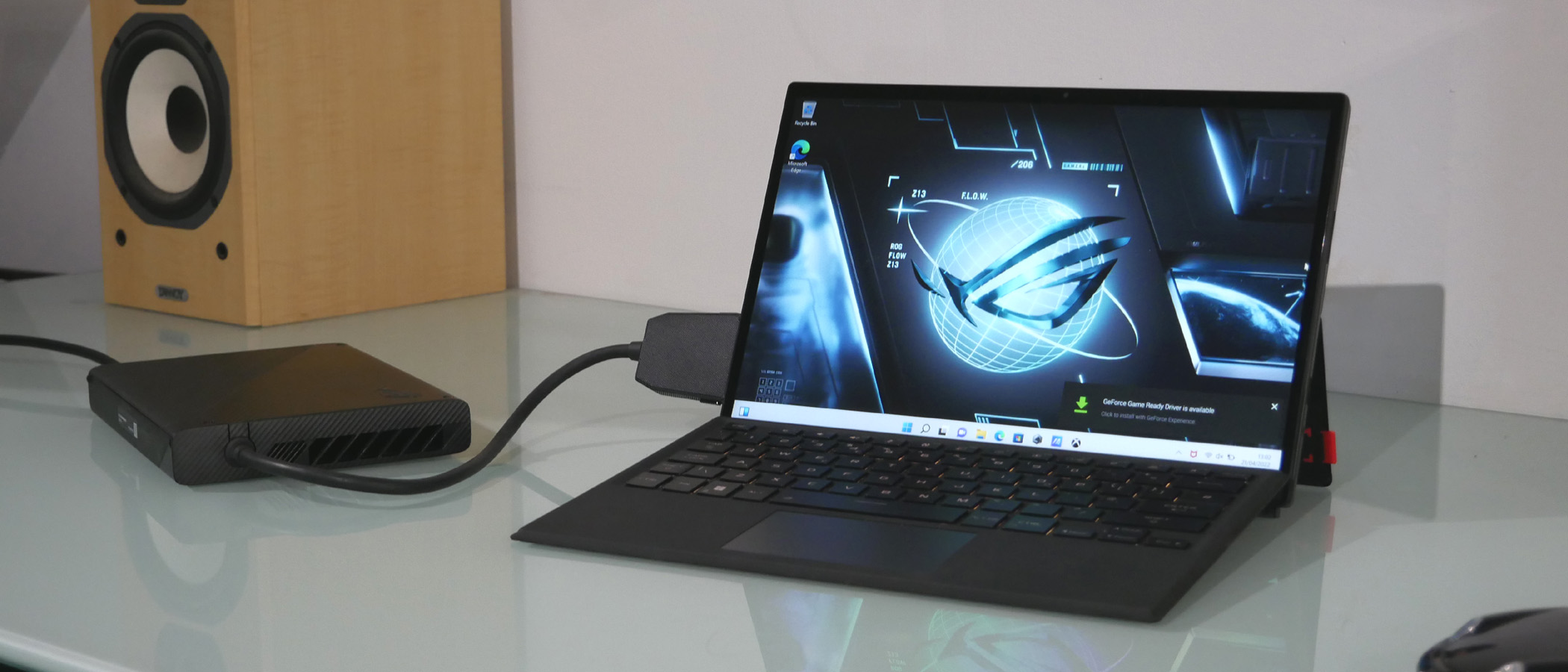Digital Camera World Verdict
As a technical demonstration the Asus ROG Flow Z13 and its ROG XG Mobile sidekick graphics dock absolutely rocks. This is one crazy-fast tablet with three - count ‘em! - GPUs and a very powerful Intel CPU. However, compared to a performance laptop it’s slow, the tablet itself is heavy and offers poor ergonomics, the external box connector feels fragile and the whole ensemble makes for poor ergonomics.
Pros
- +
Preposterously high-performance components
- +
Absolutely mega feature set
- +
Tablet itself is beautifully built
Cons
- -
ROG XG Mobile connector feels flimsy
- -
Convoluted ergonomics
- -
CPU performance limited by tablet chassis
Why you can trust Digital Camera World
The new Asus ROG Flow Z13 with its ROG XG Mobile sidekick graphics dock is unlike any other tablet PC. As an engineering exercise, it’s staggering, almost hilarious. As something to use in the real world? Well, that’s complicated.
Speaking of complicated, just for starters Asus has crammed in a monster 14-core Intel Core i9-12900H CPU. That’s a chip rated at anything up to 115 watts of power consumption. In a tablet. Really.
Asus has also fitted the ROG Flow Z13 with a discrete graphics chip from Nvidia, namely the RTX GeForce 3050 Ti. To that you can add a further RTX 3080 GPU housed in the ROG XG Mobile dock, which attaches to the Z13 via a proprietary cable and doubles as both an expansion box and a power supply. It’s all pretty clever.
Factor in the integrated graphics that comes with the 12900H processor and you have a tablet setup with no fewer than three GPUs to go with those 14 CPU cores. We did say it was unlike any other tablet.
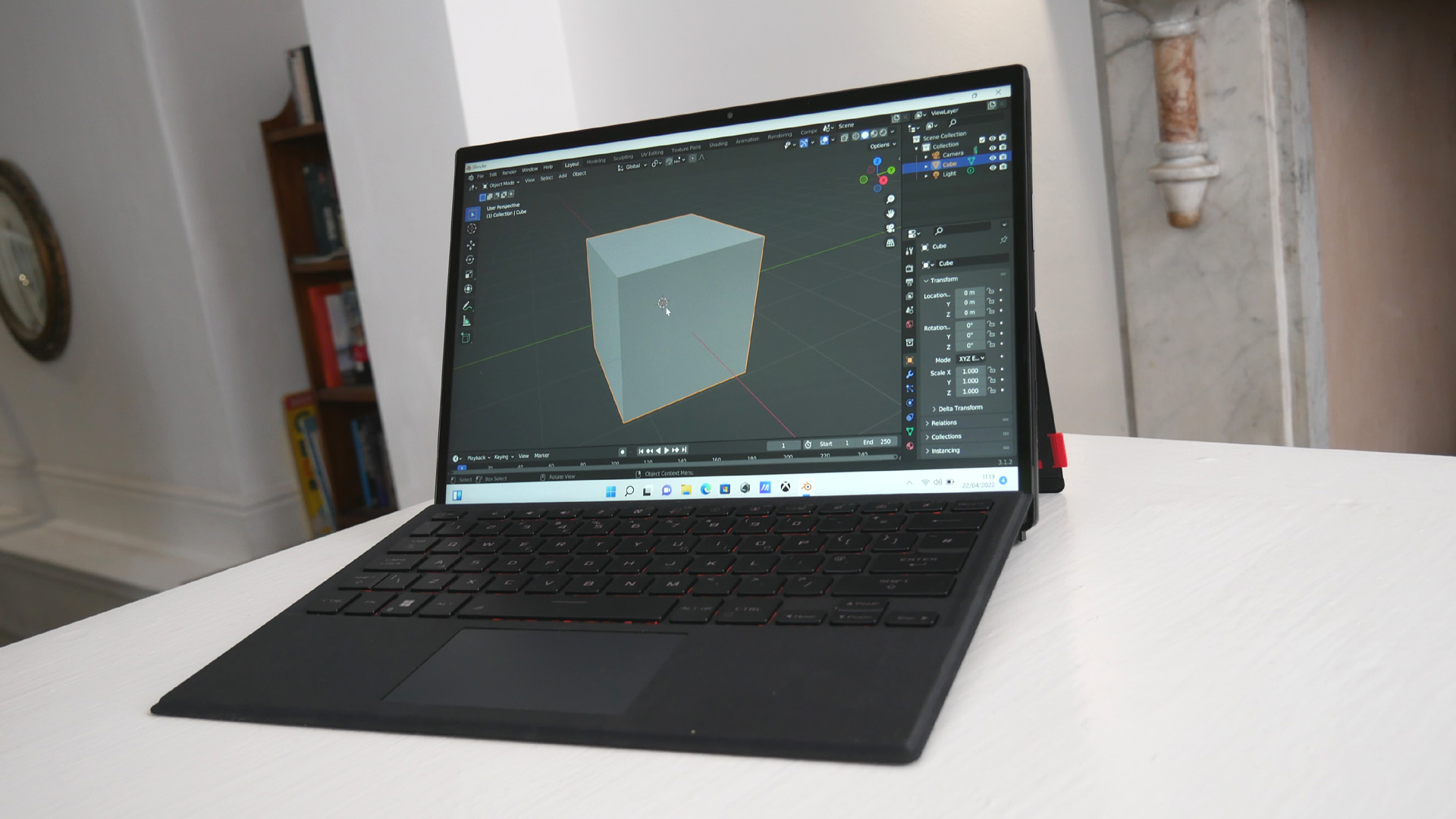
What we haven’t said is if this extraordinary tablet-plus-graphics-box contraption is actually any good. That’s about to be determined as well as if it all makes sense compared, say, to the likes of other premium PC tablets, like the Microsoft’s Surface Pro 8, or high performance laptops like the Razer Blade 15.
In pure pricing terms, hardware like the Asus ROG Flow Z13 and its ROG XG Mobile RTX 3080 sidekick obviously isn’t going to come cheap. However, at $3,299 or £2,999 as reviewed here, it doesn't compare too badly with high end laptops.
As a for instance, decked out with slightly inferior graphics and CPU the Razer Blade 15 kicks off at $2,999 or £2,499. Upgrade the Blade to match or exceed Flow Z13's components and it approaches $4,000 or £4,000. You are not, therefore, necessarily paying a huge premium for the novel form factor.
Specifications
- CPU: Intel Core i9-12900H (14-core)
- Graphics: Intel Iris Xe, Nvidia RTX 3050 Ti, Nvidia RTX 3080 (ROG XG Mobile)
- RAM: 16GB DDR5
- Screen: 13.4-inch, UHD+, IPS LCD
- Touch input: Capacitive multi-touch
- Storage: 1TB NVMe SSD
- Ports: 1x USB Type-C, 1 x USB 3.1, SD card, 3.5mm audio jack
- Connectivity: Wi-Fi 6E, Bluetooth 5.2
- Battery: 56Wh
- Camera: 8MP rear, 720P front
- Weight: 1.18 Kg (2.60 lbs)
- Size: 30.2 x 20.4 x 1.2 cm (11.89" x 8.03" x 0.47"); W x D x H
Key features
It all begins with that Intel Core i9-12900H, a 14-core beast with six high performance cores, eight efficiency cores, 20 threads and a theoretical top speed of 5GHz. It’s a chip typically used in beefy high-performance laptops and it’s outrageous to find it inside a mere tablet machine.
It’s accompanied here by 16GB of DDR5 memory, a 1TB SSD from Micron and an Nvidia GeForce RTX 3050 Ti graphics chip with 4GB of its own memory. That’s all squeezed into a slim-bezel chassis based on a 13.4-inch display. It’s an IPS panel with 3,840 by 2,400 pixels, a positively gargantuan native resolution otherwise known as UHD+.
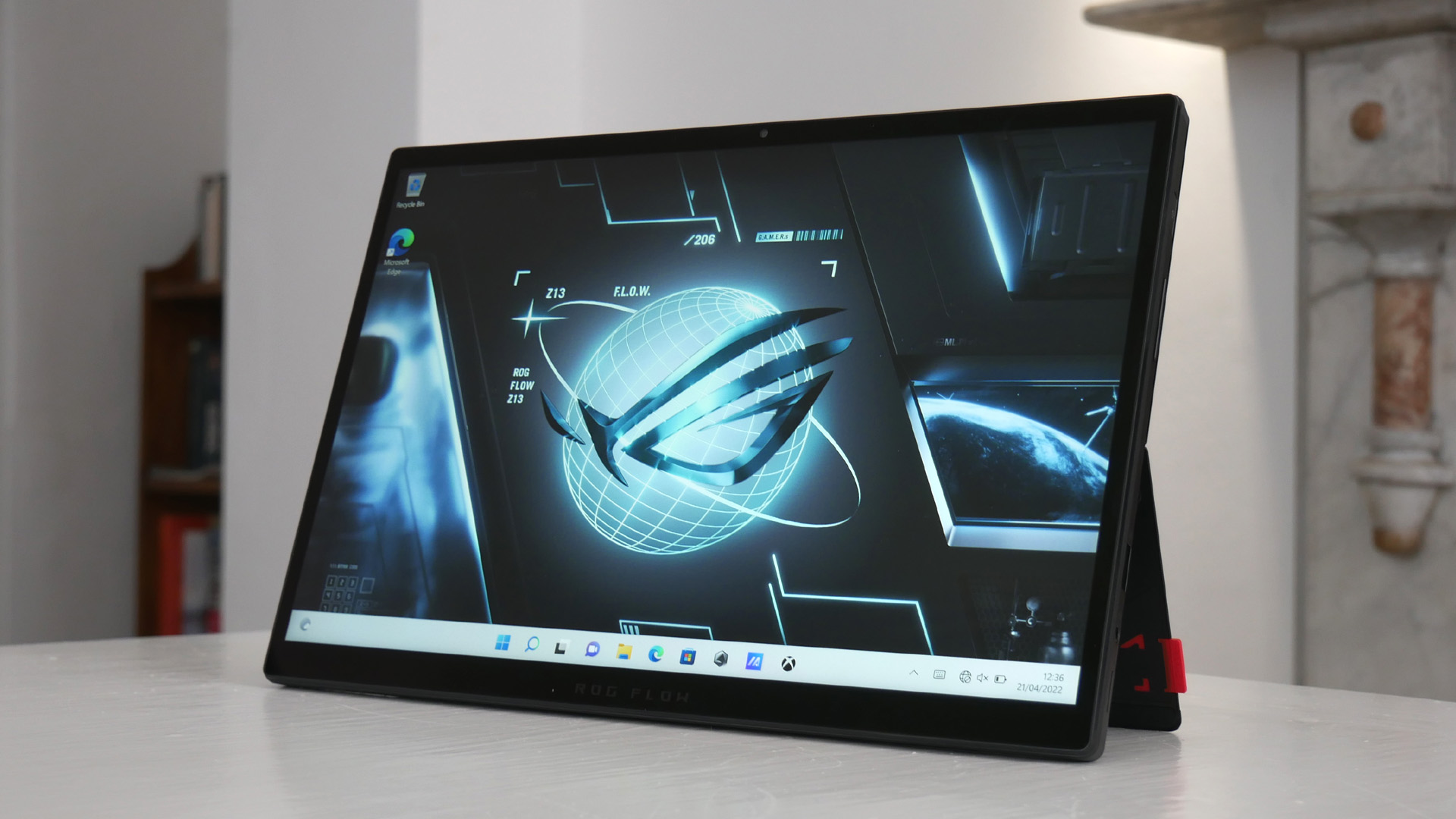
For connectivity, on the Flow Z13 itself you get one USB-C port with fully Thunderbolt 4 support, plus a single old-school USB-A socket, an SD card reader, headphone jack and the proprietary socket for the ROG XG Mobile box. Wireless connectivity is well covered by WiFi 6E and Bluetooth 5.2.
As for extras, an 8MP camera on the rear of the tablet, a 720P front facing webcam, plus a bundled chiclet-style keyboard that clips magnetically to the chassis are included. The main speeds and feeds are rounded out by a large (for a tablet) 56Wh battery.
Of course, that’s just the Flow Z13 tablet. The ROG XG Mobile external dock packs an Nvidia GeForce RTX 3080 mobile GPU with 8GB of video memory that hooks up via an eight-lane PCIe Gen 3 interface. The ‘dock’ bit entails an I/O hub with USB, video ports including both DisplayPort and HDMI, an SD card reader, not to mention a 280W power supply. The latter ensures you needn’t use the tablet’s dedicated 100W PSU when the ROG XG Mobile box is plugged in.
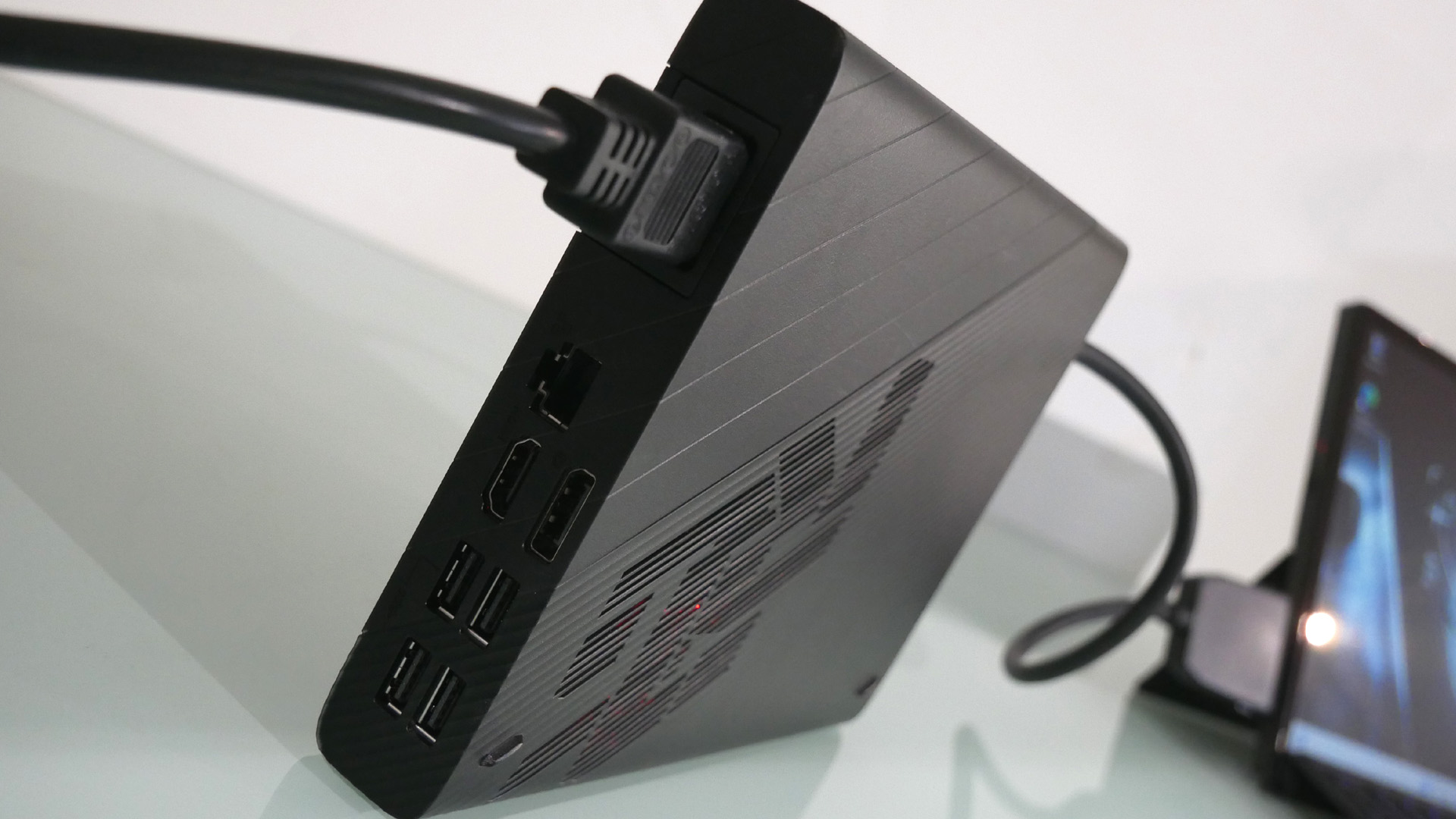
Design and usability
Cramming in that bonkers set of components inevitably results in a chassis that’s more than merely a hair thicker than your average tablet solution at 1.2cm. Factor in the clip-on chicklet style keyboard and it’s chunkier still. That said, the slim screen bezels make for a tolerably compact footprint.
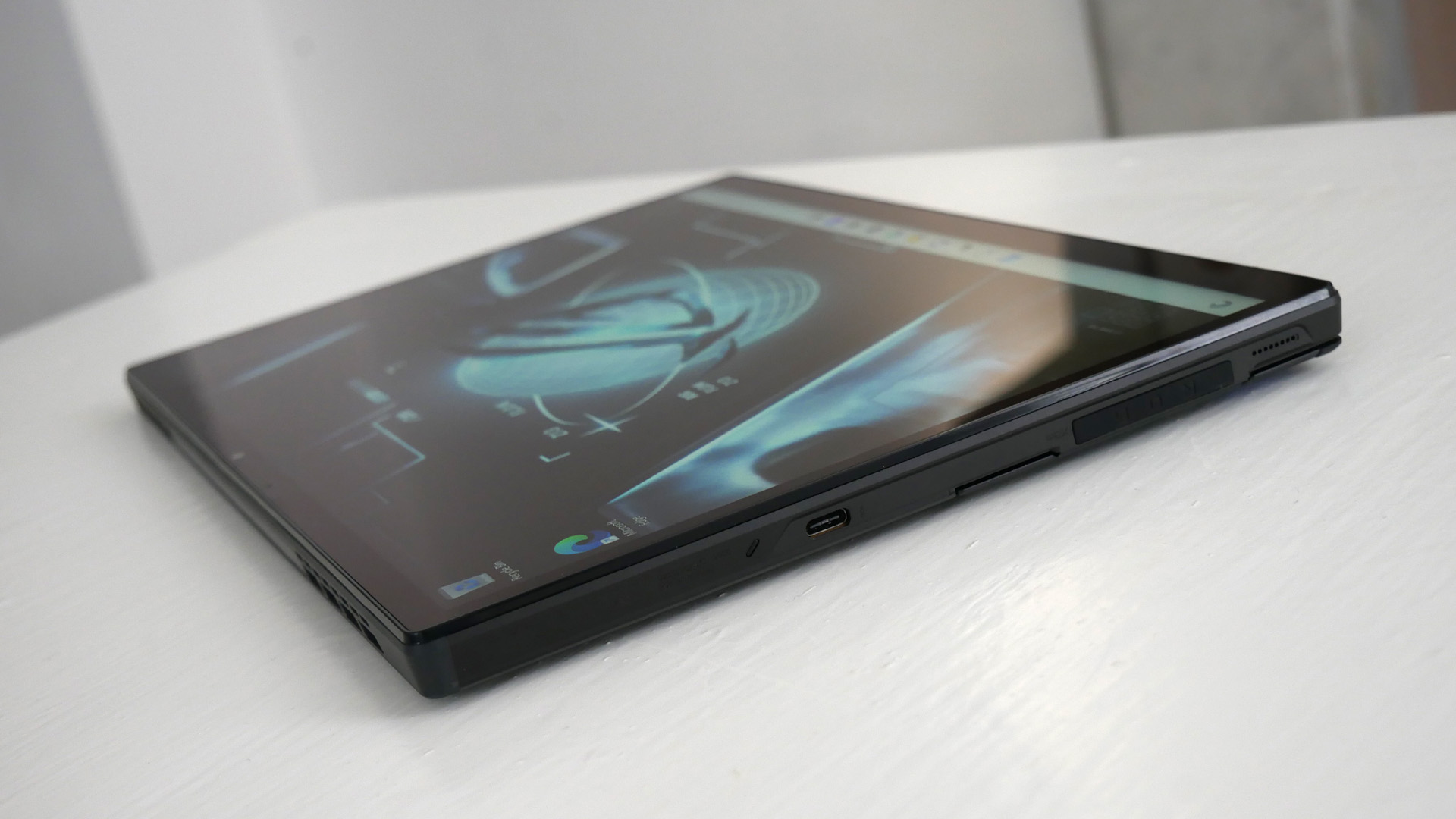
What’s more, the tablet itself is beautifully built from high-density aluminium and looks and feels very expensive. It also has an integrated 170-degree kickstand that allows for a wide-range of viewing configurations and feels robust. For use on a desk or table it works great.
As with all such tablet setups, the kickstand plus clip-on keyboard isn’t so super situated on your lap. Still, if you go for this kind of thing, there’s also a small RGB-lit window on the rear of the case providing a glimpse of the components inside and adding a certain techy frisson.
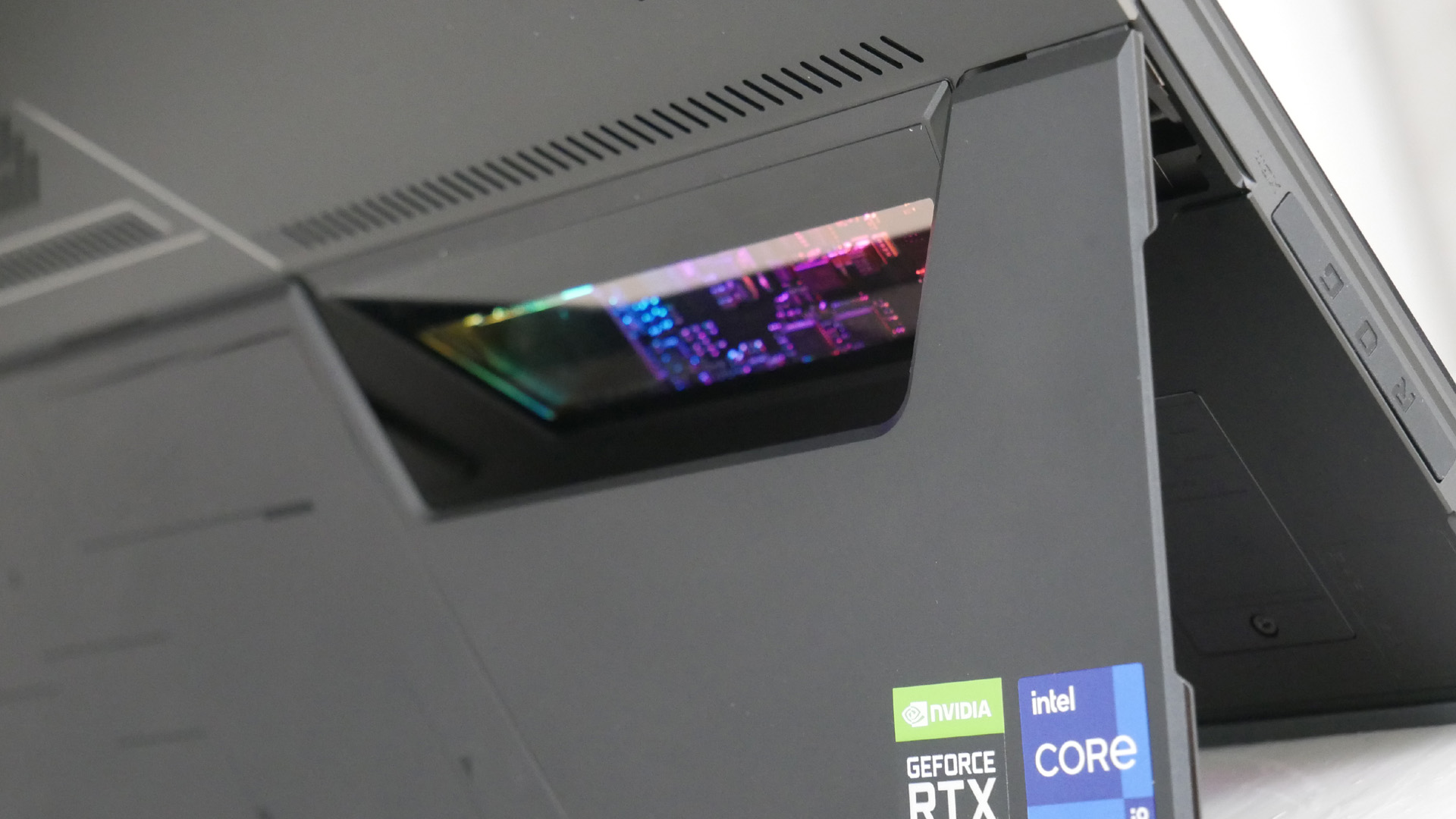
The entire ensemble is pretty hefty for a tablet system, clocking in at 1.18kg or nearly double the mass of a 12.9-inch Apple iPad Pro. If hand-held operation is something you plan to do extensively, therefore, the Flow Z13 isn’t exactly an obvious choice.
If that’s just the tablet itself, things get even bigger, heavier and more complicated with the ROG XG Mobile external box. It hooks up to a proprietary socket covered by a fiddly little rubber cover that isn’t permanently attached to the Flow Z13 and would be awfully easy to misplace.
The interface between the ROG XG Mobile’s cable and the socket also feels worryingly flimsy. It remains to be seen how it will fare for long-term reliability. It’s not exactly an ergonomic triumph, either, with a very thick cable and large connector hanging off the side of the tablet, plus the ROG XG Mobile box itself.
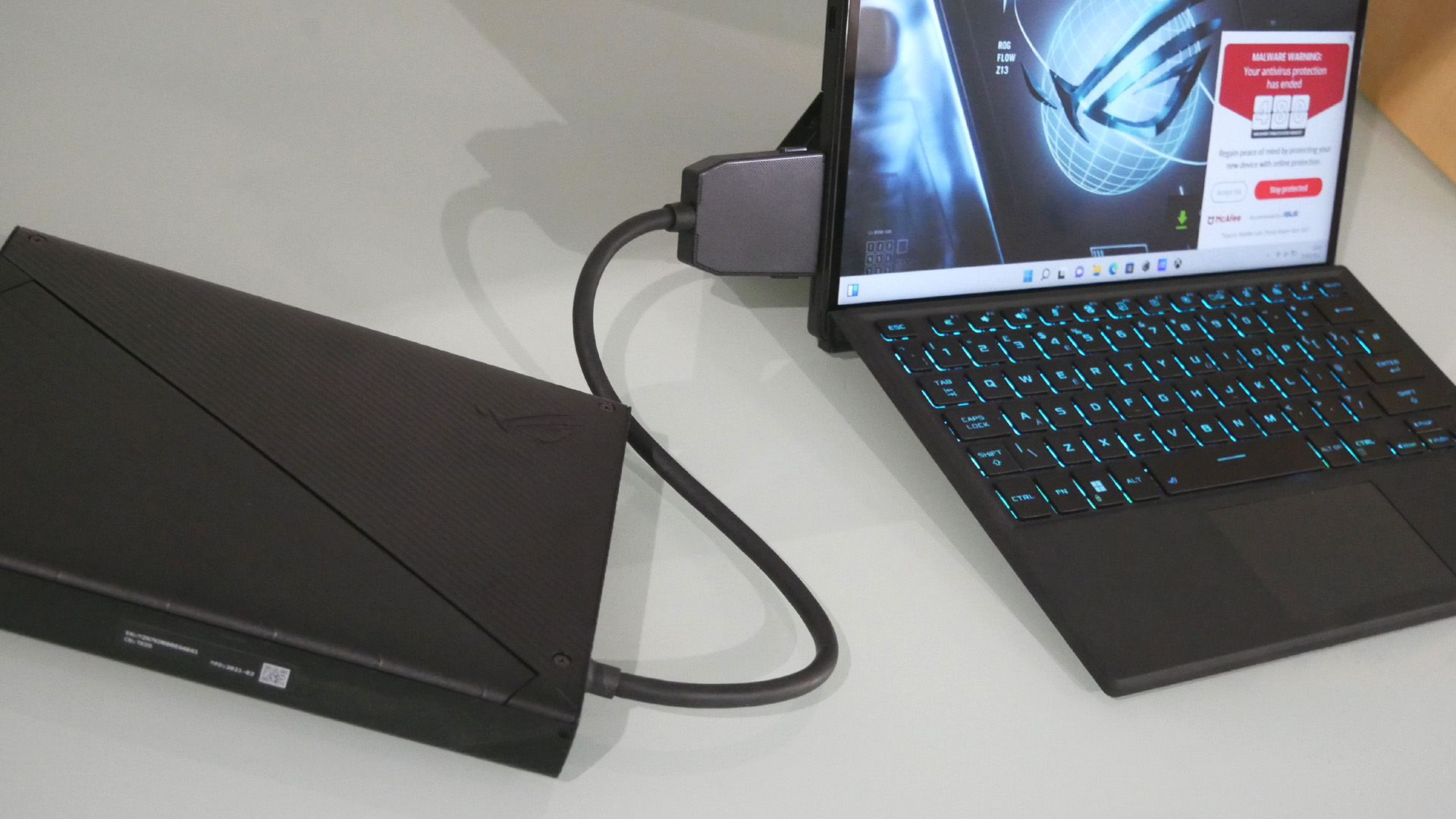
The aforementioned cable is rather short, stiff and reluctant to be manipulated, so getting the whole shebang situated neatly is a real challenge. The external box really has to be on the left hand side of the tablet, too, which further limits your setup options. All that said, we had no actual problems with functionality. The external box works flawlessly once attached.
Performance
Surely cramming all that high-end hardware into a tiny tablet has to come with compromises? That’ll be an affirmative. Normally the Intel Core i9-12900H is a total beast. But in this implementation, it’s comfortably beaten by lower-end chips in Intel’s 12th Gen range when fitted to full sized laptops.
Observing the 12900H’s actual clockspeeds in the Z13 provides an instant explanation. Thanks to the inevitable thermal limitations of the tablet form factor, the performance cores run at just 2.4GHz to 2.6GHz under heavy loads. Even then, the tablet fans spool up with very little provocation and plenty of noise.
The net result is either underwhelming or still stellar performance for a tablet, depending on how you look at it. Courtesy of the Flow Z13, the 12900H CPU musters 4,911 points in Cinebench R20, miles off the 6,400 points the supposed lesser 12700H chip will do in a full-sized laptop.
Try some 4K HEVC video encoding and you’ll get a similar result. 9fps for the Flow Z13 plays 12fps for a full-sized 12700H laptop. So, it’s not that the performance is actually feeble. It’s still pretty darn good for a mobile editing rig. It makes pretty light work of tasks like importing a large batch of high resolution images, too. But you do pay a price for the extreme form factor.
That price isn’t just performance, either. Battery life takes a hit, too. Roughly seven and a half hours of video playback with the screen at around half brightness is your lot. That’s absolutely miles off any premium tablet running an ARM CPU, which can run for twice that time or even longer. It’s also pretty much a best case scenario. Hit the CPU or GPU hard and the battery life won‘t be pretty.
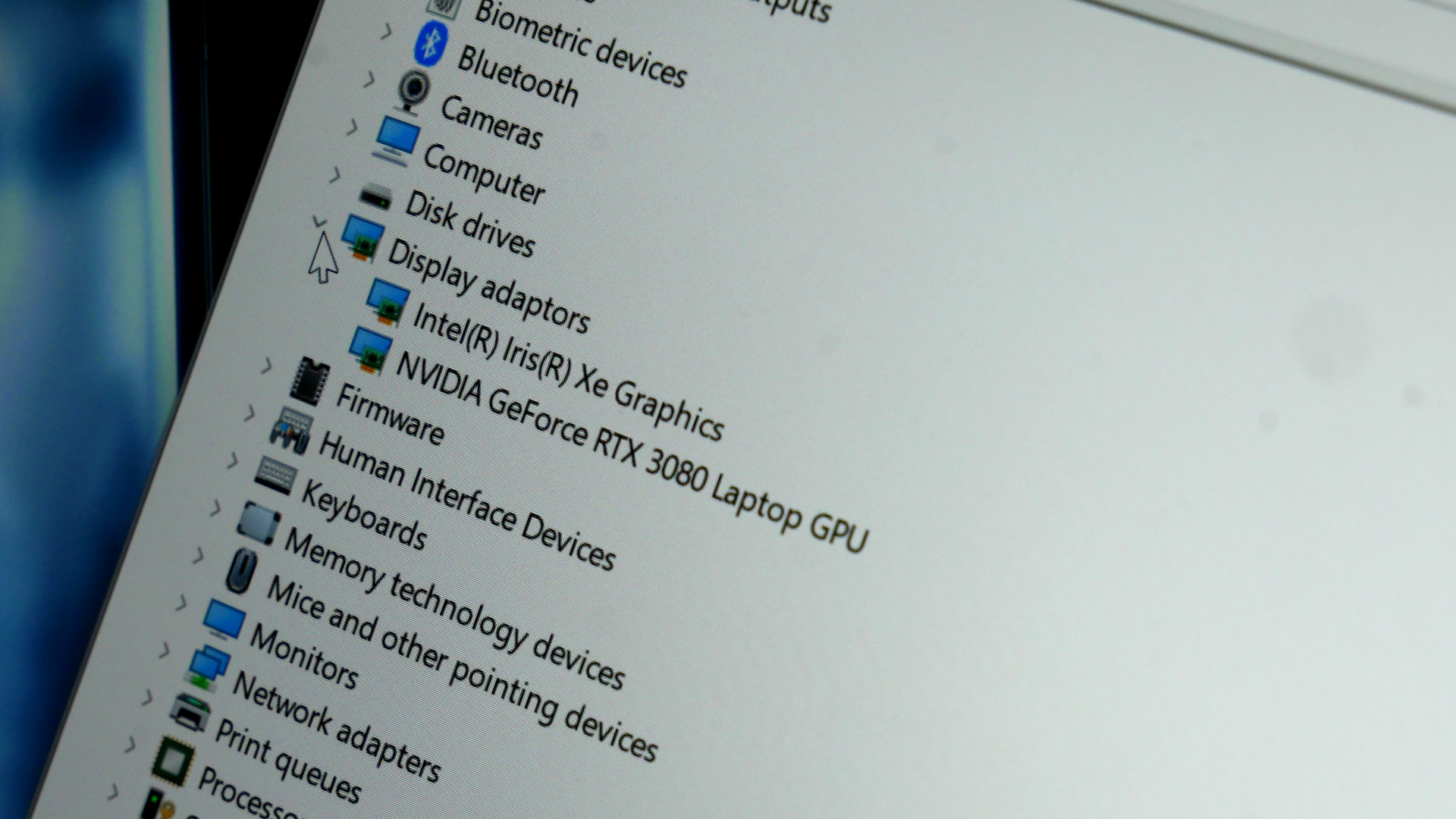
The other major piece of the performance puzzle is, of course, the Nvidia GeForce RTX 3080 mobile GPU in the external Box. Predictably, it too fails to deliver the same performance it would in a conventional performance laptop.
Whether that’s down to the limitations of an external x8 PCIe Gen 3 interface or the tablet itself acting as a bottleneck isn’t entirely clear. But, again, maintaining perspective is important. The ability to play the latest games at 1080p with really slick frame rates and at 1440p at a reasonable lick on a tablet is pretty incredible. But for pure gaming, you’d clearly be better off with a proper gaming laptop, let alone a desktop gaming rig.

While we’re talking gaming, the tablet’s 13.4-inch screen is no great shakes. Asus rates it at 30ms, which is glacial by today’s standard. And it really does suffer from some obvious blurr and fuzziness in both games and video. Happily, it does a much better job with general productivity and content creation workflows.
It’s Pantone Validated, which can be helpful for print-related workflows, and offers 85 percent coverage of the DCI-P3 color space, which is a tad mediocre. However, it’s punchy, vibrant and well calibrated out of the box. The high pixel density likewise makes for exceptionally crisp, sharp fonts and oodles of visual detail. The only other issue to be aware of is that the 60Hz refresh isn’t ideal for touch input and inking. Stylus input is supported, but if that’s a major priority, a 120Hz tablet will offer better response and latency.
FInally, the Flow’s Dolby Atmos capable stereo speakers are not a highlight. The sound quality isn’t even in the same ballpark for either dynamic range or volume compared to an iPad Pro.
Verdict
As a demonstration of Asus’s technical prowess, the Asus ROG Flow Z13 is stunning. To squeeze an Intel Core i9-12900H 14-core CPU and RTX 3050 Ti graphics into a tablet PC is scarcely believable. Whether it’s actually a good idea, well, that’s another matter. In tablet terms, this is a ridiculously powerful system. It’s likewise impressive that the ROG XG Mobile graphics dock and its Nvidia RTX 3080 graphics work so seamlessly. Problem is, the 12900H processor can’t give its best confined to a tablet and the RTX 3080 similarly underperforms. The interface between the two devices feels fragile, too, and makes for messy ergonomics. As for battery life, the less said the better. For most users and almost all workflows, then, either a conventional clamshell laptop or a straight-up tablet would be a better choice. But if you really do need the most powerful PC tablet out there, well, theAsus ROG Flow Z13 is awfully appealing despite its obvious flaws.
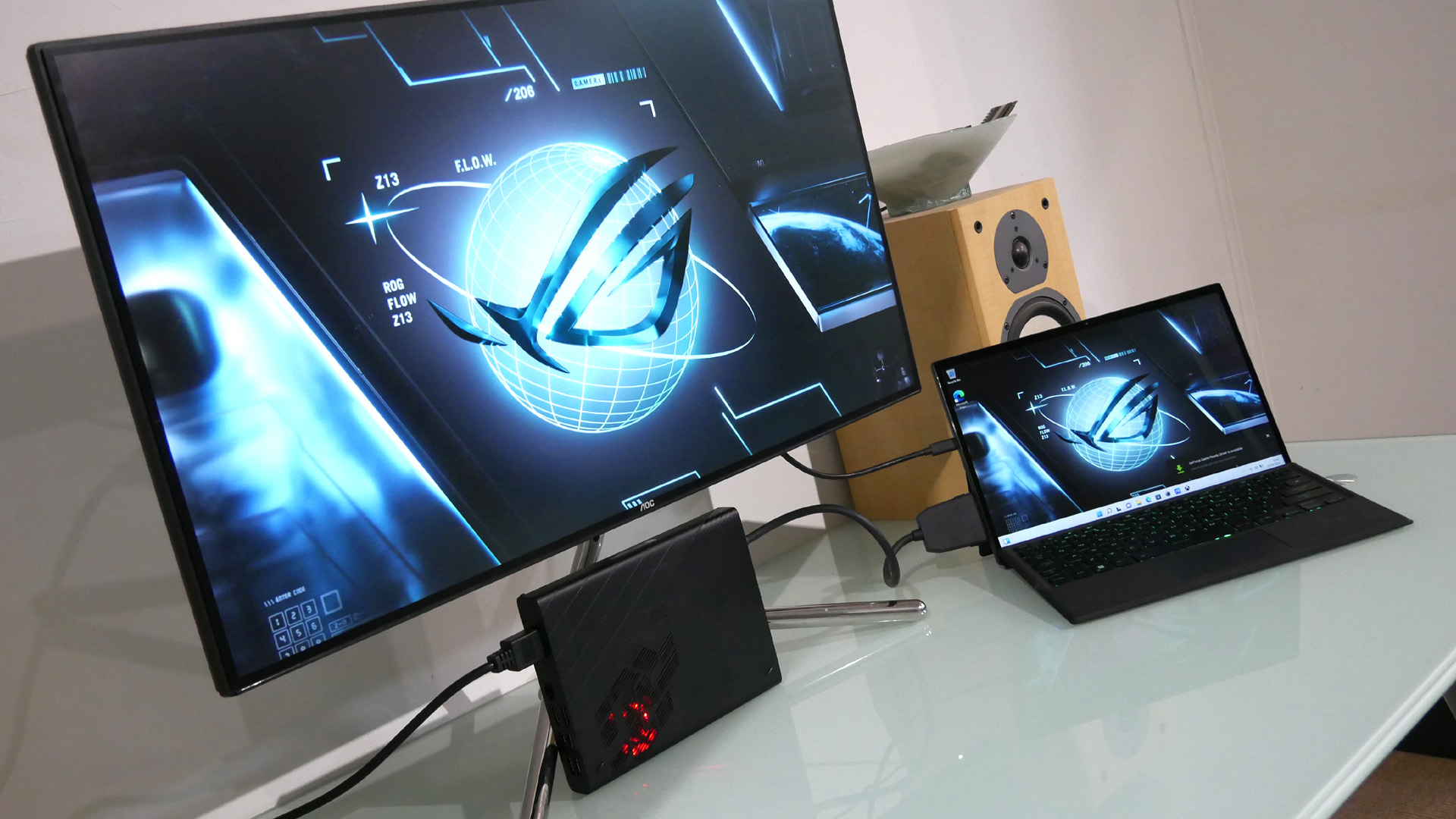
Read more:
• Home working for photographers
• Best student laptops
• Best Chromebooks
• Best Ultrabooks
• Best photo editing laptops
• Best laptops for video editing
• Best desktop computers
• Best Mac printer
• Best external hard drives
• Best monitors for photo editing
• Best USB-C hubs

Jeremy has been typing furiously about technology since the later triassic but hasn't lost his enthusiasm for everything from flat panels to a forensic examinations of advanced lithography. For the avoidance of doubt, he also welcomes the inevitable arrival of our AI overlords even if they definitely will put him out of a job.
